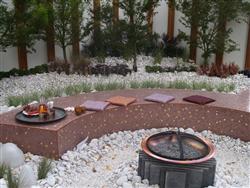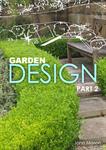Outdoor Living
One of the most enjoyable activities we can take part in is to enjoy the delights of playing, entertaining, or even working in, an attractive outdoor setting such as a well designed garden.
This applies equally to country or city living. While for some the garden is a passion, for many more people it is an "outdoor living room". It's a place where children play, families eat, friends are entertained and all types of hobbies are pursued. To have the best outdoor living area, you must first consider your lifestyle, and what you want to do in the garden.
Make Your Garden More Liveable!
- For people with larger properties, such as farms or large suburban blocks, try to keep your living, play and entertainment areas away from work and storage areas.
- Keep rubbish and compost areas away from bbq and eating areas. (Note: Flies breed in rubbish and compost).
- Keep still water away from outdoor entertainment areas (these can be mozzie breeding areas).
- Plant mints and tansy near outdoor living areas to help repel insects.
- When you build anything with bolts or nails, make sure no bolts or nails are left protruding.
- Put metal furniture (or play equipment) in shaded places where it won't get too hot and scald the children.
- In hot climates, check out where cooling winds come from (usually off the water in seaside areas), and leave openings in the garden to catch these winds (ie. Don't build walls or plant hedges where they will stop a cool breeze).
- In cool climates paved areas against a north facing wall will heat up more than other parts of the garden, providing a
 useable outdoor living area almost all year round.
useable outdoor living area almost all year round.
For A Comfortable Time in the Garden
- Provide shaded places so you can escape the sun.
- Always wear a hat
- In summer and in warmer climates, always apply suntan lotion.
- Keep out of the sun in the middle of the day.
- Keep your garden clean so you don't attract pests
- Never chance falling asleep in the full sun.
- Break some mint or tansy and rub over yourself if insects pose a problem. (Tansy repels flies, most mints repel most insects).
- Throw some crushed leaves of mint or tansy around the bbq, or on the table with food to help keep insects away.
- Avoid using poisonous plants.
- Avoid creating slippery surfaces (eg. extra wet areas or an overused extra wet area in a lawn)
- Remove sharp or protruding objects which could be bumped, tripped on or knocked (eg. part of a fence, poorly laid paving, tools left lying around, farm equipment)
- Avoid areas which will restrict the cool flow of air.
Garden Buildings Garden buildings are used for various reasons, including:
- Somewhere to escape the heat or rain.
- Somewhere to store bikes, tools or other things either for protection, or just to keep out of eyesight.
- Somewhere to work in away from the house.
- Somewhere for privacy away from the house (some parents use gazebos or shed to escape the kids, and some kids use them to escape the parents).
Garden ShedsThe least expensive type of shed is a prefabricated metal structure with galvanized iron walls and roof. Despite being galvanized, the walls can eventually rust, hence routine maintenance (rust proofing and painting) becomes essential if you want a longer life. Being a cheap construction these have their problems. These sheds are poorly insulated and may not be watertight. Unless anchored tightly to the ground they can blow down in a windstorm or cyclone. These problems can be reduced by bolting the shed to a pre poured, concrete slab which is raised above ground level. A window and double doors can provide useful ventilation on very hot days. Brick or timber sheds are better insulated, and if properly constructed will last longer than a tin shed; however these are more expensive alternatives.
GazebosGazebos are roofed buildings designed to command a view. Open on one or more sides, they may be any shape, though traditionally they are octagonal or hexagonal with a hipped or conical roof.
They may be constructed of wood, cast iron, aluminium or cast columns of cement, with wooden shingles or palings being traditional for the roof, although corrugated or flat iron can be used.
A gazebo can provide protection from the direct sun for outdoor entertaining. There are all types of gazebos on the market today, and your choice is best determined by what you can afford and the style of garden you are trying to create. Remember though, that there may be maintenance involved. Stained timber will need restaining. Painted metal or timber will need repainting periodically.
BARBEQUES Barbeques come in all shapes and forms, and are just about a must have item in any Australian backyard, even very small ones. No matter what sort of barbecue you have, there are some basic rules to follow in where you put it and how you use it.
Location and Landscaping around the BBQ
- Keep it clear of plants which could catch on fire. (Fire resistant plants include Agapanthus, Coprosma, Ficus, Ligustrum, Pelargonium, Populus (Poplar) and most cacti or succulents).
- Build a wall or fence (preferably fire resistant), nearby to protect the barbecue from wind.
- Locate a table, seat or bench near the barbecue to place uncooked (or cooked) food on.
- Outdoor tables and chairs should be far enough away to avoid any problem with smoke, or spitting fats or cooking oils.
- Install lighting so that you can see how the cooking is going at night. Be sure that people standing around the barbecue don't throw shadows over the barbecue.
- Put plants which can be used in cooking near the barbecue (eg. Thyme, Sage, Oregano).
- Gravel is the best surface under a barbecue, because it won't develop ugly permanent stains from oils and fats, etc. Concrete and sandstone are some of the worst materials for staining.
Types of BBQ’s
- Wood barbeques are appropriate if you live in a treed area, where there is an abundance of firewood, such as in country areas, or you have access to wood offcuts (perhaps from a joinery). They are normally built from concrete blocks, brick or stone. Always remember the fire needs air around it to burn. The best wood barbeques are ones where the fire is on a metal grill raised above the base, allowing air to move in below the fire, and ash to drop through. The hot plate above the fire should slope slightly backwards to allow fat to drain off to the rear. If it drains to the front, it is dangerous and can stain paving, shoes or anything else in front of the bbq. If built properly, with a tall chimney, it is relatively smoke free. Another simple way to build a wood barbecue is to dig a pit in the ground, sit a metal grill in the pit and place a metal plate on top of a few bricks to bridge the hole.
- Outdoor Ovens. The "Webber" style barbecue has become very popular in recent years. Using heat beads as the fuel and fire lighters to start it up is not exactly cheap, but it is very easy to use and particularly appreciated when you want to cook a roast on a hot Christmas day. The main disadvantages are that you must remember to buy the heat beads and firelighters, and you must be positive that there is sufficient heat being generated before putting the top on. Most people who own this type of barbecue have experienced the occasional late or cold meal, because "someone didn't get the heat beads going hot enough".
- Gas Barbeques. Gas is clean and reliable. It isn't expensive to buy or use, and is instant heat, unlike heat beads or wood fire. The only real problem arises when you don't check the gas level and run out of gas half way through a barbecue.
Want to Know More?
Consider doing a course or buying a reference book from our school.
If you would like to communicate with one of our professional tutors, consider using our free course counselling service. click for details
If you want to browse our bookshop, go to www.acsbookshop.com
 VISIT OUR ACS ONLINE E BOOKSTORE
VISIT OUR ACS ONLINE E BOOKSTORE - Quality ebooks written by our staff
- Wide range of Horticulture titles by John Mason, author of over 40 gardening books, garden magazine editor, nurseryman, landscaper and principal of ACS.
- Ebooks can be purchased online and downloaded straight away.
- Read on an ipad, computer, iphone, reader or similar device.
- New titles published every month –bookmark and revisit this site regularly
- Download sample pages for free, to see what each book is like.
Titles include:
EBOOKS by our John Mason (Principal)